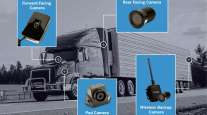Special to Transport Topics
Industry Works to Make Tractor-Trailer Connections More Efficient

[Find the latest in equipment & maintenance: Explore this quarter's issue of Calibrate]
As more data is being shared between trucks and trailers, the trucking industry is working to standardize the connections of the future. In the meantime, fleets are looking for solutions — some of them low-tech — to ensure trucks and trailers talk to each other now.
The standard U.S. configuration is a seven-pin J560 electrical cable along with two pneumatic cables used for braking. But Robert Braswell, executive director of the American Trucking Associations Technology & Maintenance Council, recalled a survey of TMC fleets where roughly 30% said they were using a second electrical cable in at least some applications.
Although Braswell noted that TMC members are not representative of the entire trucking industry, most carriers are using one cable.

A driver hooks up the air lines between the tractor and trailer. (RCarner via Getty Images)
In Europe, two wires are standard, but the issue is still being contemplated in the United States. Increasing amounts of data are shared by tractors and trailers for telematics, 360-degree visibility and sensor-based maintenance. TMC has been helping lead the discussions about the future that have involved all the trailer and tractor manufacturers along with third-party telematics providers.
“The whole smart trailer world is up in the air,” he said. “It’s the wild, Wild West.”
Braswell said future connections could include a J560-compatible connector that has more than seven circuits — what once was called a “smiling jack” connector. There’s been talk of wireless connections. He believes standards could coalesce by the end of the decade.
“There’s going to be a push for standardization,” he said. “The fleets will insist on it.”
Mike Grima, vice president of equipment services for Yellow, said his fleet’s standard seven-pin connection means there are 14 connections, seven on each end. But once a second trailer is added, that number increases to 42 between the tractor, the two trailers and the dolly connecting them.
In other words, Grima said, that’s “42 opportunities to have a failure.” But Grima said future technology could reduce the number of connections.
“There’s constant evolution of technologies that may provide other solutions in the future that include reduction of the number of connections,” he said.

Arguably, the tractor-trailer connection is the vehicle's most vital, yet low-tech component. (Quianli)
Yellow ranks No. 10 on the Transport Topics Top 100 list of the largest for-hire carriers in North America.
Braswell said maintaining the cables requires frequent attention. They are wearable items, not durable ones.
“You’re going through them like crazy, if for no other reason than sometimes you forget to hook them up and they get drug down the road or they’re improperly connected or they’re unmated in a rough way for some reason,” he said. “Somebody forgets to disconnect when they’re doing the separation. There’s all sorts of ways you can damage these things. The driver should be diligent about how they hook up and separate, and you’ve got to be diligent about the maintenance of the systems to begin with.”
Braswell said TMC has a list of best practices. For the electrical coil, technicians should look for abrasions, cuts and cracks in the green cable jacket. Technicians should ensure the integrity isn’t compromised so there is no entry point for corrosion. Sometimes sunlight can degrade the jacket, so if it’s faded into a chalky looking green, it’s probably brittle with hairline cracks. Dirt and corrosion should be removed with a wire brush and a cleaner. The plug and socket terminals should be coated with corrosion prevention material. A lubricant or sealant can keep out moisture.
More Q4 Calibrate
►Formulate Recap: Homer Hogg of TravelCenters of America
►Five Questions: Ginnapher Velez, Clean Harbors
►Freeze: Making the Electric Transition
►TMC Corner: Recommended Practices are the Foundation of Maintenance
►Baxter: Challenging Truck Makers' Emissions Systems
Explore the Issue!
Technicians should repair and replace loose or poorly made terminal-to-wire connections. They should check the conditions of the plug’s spring-loaded female terminals, as well as the male pin sockets to ensure they’re making good contact where mated. Technicians probably want to check the voltage to ensure sufficient power.
For the pneumatic cables, they should look for kinks in the line and abrasions or cuts in the outer jacket. The tubing underneath should be in good condition. Just as with electrical lines, sunlight can fade the tubing’s outer layer, which can make it brittle and cracked. They should listen for air leakage when the system is pressurized, and look for excessive sag when hooked up. They should inspect the fittings and ensure the seals are proper in the gladhands. Springs holding cables in place should not be damaged, loose, have sharp edges or have rusted components.
Braswell said technicians shouldn’t allow the cable to sag or be in a position where it can be snagged, chafed or cut.
Nussbaum Transportation addresses that issue by using 12-foot cables rather than 15-footers, said James Grier, the fleet’s director of fleet service. He explained that they have less chance of being snagged. The shorter cable can be pulled from the back of the cab, but proper attention and maintenance can prevent problems from sharp lefts and rights.
“The 15-foot just kind of invites more opportunity for rubbing and snagging, which we don’t want,” he said. “We want to avoid any DOT issues that we could possibly have, and we’ve had very little of it with the 12-footers.”
Greg Pawelski, vice president of health and safety at XPO Logistics, said his fleet also uses a 12-foot cable, which doesn’t drag, including in tight turns. XPO Logistics mostly uses a single electrical connection, with a second provided for a dedicated lift gate trailer. XPO Logistics’ ongoing trailer charging system allows it to avoid the second connection. XPO Logistics ranks No. 3 on the TT Top 100 for-hire carriers list and No. 6 on the TT Top 100 list of the largest logistics companies in North America.
Yellow’s Grima said fleets are in a constant battle with corrosion-causing moisture. The problem is made worse by magnesium chloride, which is used to treat roadways for ice and snow. It draws moisture from the air. Once it gets into a wiring harness, it acts like a sponge and can wick upstream or downstream, causing corrosion farther down the line. To prevent that from happening, Yellow technicians encase the wiring with a plastic sleeve, heat it and shrink it, while a glue helps create a watertight connection. The fleet has also moved to soldered connections rather than crimp connections for repairs. These are sealed with a watertight shrink tube.
Keeping Up With Technology
Grima emphasized the importance of an effective technician training program. Technology is constantly changing, and electrical systems are the most challenging repairs for technicians.
“Mechanics are typically left-brainers,” he said. “They think in pictures. They look at things and can understand by seeing. In electrical, you can sure feel it, but you can’t see it, so it’s hard to understand and difficult to diagnose.”
Just as training technicians is important, so is training drivers. Daniel Mustafa, director of technical service for Travel Centers of America-Petro, said failures most often occur when drivers fail to disconnect when they drop the trailer. Drivers need to note damage when it occurs, and should be trained to correctly identify when a lighting issue occurs on the tractor side.

Penske has found success by using a two-spring configuration design. (Penske Logistics)
When the driver initially hooks up, all the lights should be off, Mustafa noted. The surge of energy if there’s already power can cause fuses to blow and circuit breakers to overload. A breaker automatically can reset without the driver knowing it. They may report an issue with the trailer when the problem was with the tractor.
Last year, Penske Logistics, which ranks No. 15 on the TT 100 for-hire list, worked with Phillips to better understand the best configuration for the springs that suspend the cables and ensure they return to their original position when the truck and trailer come back in line.
Chris Hough, Penske vice president of maintenance design and engineering, said any vehicle Penske purchases has the same design where all three lines are encased together by a single black plastic wrap.
The company discovered through experimentation that a two-spring configuration was superior to the single heavy-duty spring Penske was using. The single spring tended to get stretched so the cables would sag and chafe. Meanwhile, the company began using a counterclockwise rather than a clockwise loop. It helps the cables come back together after the truck and trailer straighten out after a turn.
Penske worked with Phillips to replace the cable’s aluminum extension with a rubber one that is rigid enough for the driver to grasp but flexible enough to bend when the situation calls for it.
Want more news? Listen to today's daily briefing above or go here for more info
Ryder has a seven-pin connector as a standard in its rental fleet, plus a two-pin connector for lift gates or varying offloading devices. Lease truck customers may even have another wire. Ryder ranks No. 11 on the TT 100 for-hire list and No. 13 on the TT 100 logistics list.
Ryder’s David Kegley, who serves as its manager of maintenance training, said for the past couple of years the fleet has moved away from cast aluminum connectors to a nonconductive, nonmetal one with multilip seals. He emphasized the importance of inspections. Any abrasion can start the corrosion.
“Key is the preventive maintenance inspection, and to be able to identify small things that cause big problems,” he said.





